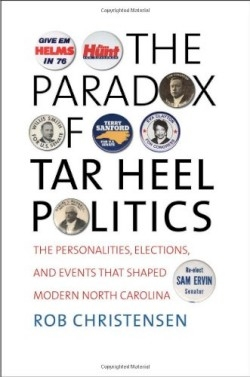The Paradox of Tar Heel Politics
The Personalities Elections and Events That Shaped Modern North Carolina
Rumors circulated through the state. Armed men in red shirts disrupted political rallies. Regional newspapers reported that the wife of George Henry White, the last Black congressman from the Reconstruction era, had received a shipment of rifles. Citizens were pulled from their homes and whipped. The 1898 election was a landslide for the Democratic Party in North Carolina, ushering in a seventy-year era of domination in state politics. But progressivism and populism were not dead.
Christensen, a thirty-four-year veteran writer and political columnist at the News and Observer in Raleigh, investigates the deep ambivalence North Carolina voters have shown toward supporting purely racist politics. Concentrating his focus on the upper level of state politics, the battles for the offices of governor and senator, Christensen explains the see-saw of Tar Heel sentiments.
After the 1898 election, the Republican Party, which strongly identified with the Radical Reconstruction and the Civil War, was driven from power. Two wings of the Democratic Party developed. The conservative wing concentrated its efforts on disenfranchising black voters by passing literacy tests that changed at the discretion of the poll workers to ensure a suppression of the black vote, stopping union organizing and government expansion, and opposing federal intervention like integration. The progressive wing focused its efforts on attracting industry and raising taxes to fund education, pave roads, and supply electricity to rural populations. Both wings supported racial segregation right up until the Lyndon Johnson beat the Barry Goldwater in 1963 and went on to pass the Civil Rights Act the next year.
But it wasn’t until 1972 when Jesse Helms, an ultra conservative radio personality and political consultant ran as a Republican, that the stranglehold of the Democratic Party was broken. Frank Rouse, Republican Party chairperson in the 1970s said: “You don’t want to hear this. It’s race in North Carolina. That is not a supposition. That is a fact. The Republicans resent the fact that blacks bloc vote for Democrats…” Conservative Democrats flocked to the Republican Party, a move mirrored throughout the South that set the stage for the era of “Ronald Reagan conservatism.”
Christensen describes how the same state can simultaneously elect candidates like Helms (Republican senator 1973-2003), who made racial politics a signature, and John Edwards (Democrat senator 1999-2005), a populist who supported unions, universal healthcare, and ran a progressive campaign for president until January 2008. Christensen thoroughly covers his topic and lets the North Carolina high-office seekers reflect the mass organizing that occurred for civil rights, union rights, and education throughout the country.
Reviewed by
Deirdre Sinnott
Disclosure: This article is not an endorsement, but a review. The publisher of this book provided free copies of the book to have their book reviewed by a professional reviewer. No fee was paid by the publisher for this review. Foreword Reviews only recommends books that we love. Foreword Magazine, Inc. is disclosing this in accordance with the Federal Trade Commission’s 16 CFR, Part 255.

